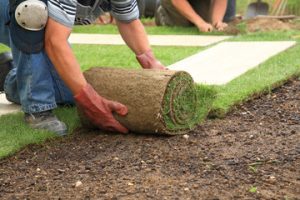Imagine stepping out into your backyard to find a burst of colors, soothing sounds and invigorating scents. Landscaping can do more than just add beauty – it can also improve your quality of life and increase property value.

Landscapes are created by adding plants, changing the terrain and building structures. The elements of color, form, lines and texture are all important in a successful landscape design. Visit https://oceaniclandscaping.com/ to learn more.
Color is a powerful design element that can set the mood and draw the eye. Warm colors like red and yellow evoke excitement and make objects feel closer, while cool colors like green and blue offer a sense of balance and harmony. Landscaping companies can use color to communicate their brand’s personality and create a distinctive look that customers will recognize.
Colorful, diverse plantings and seasonal color programs are popular with many clients because they add an extra pop of curb appeal to properties. Heroman says he typically installs spring plants in late April or early May and switches to fall colors in late October or early November.
In addition to planting and gardening, landscapers can also incorporate hardscapes into their projects. This includes walkways, patios, and other outdoor living spaces that provide value to homeowners by making their homes more livable and entertaining friendly. Landscaping can also incorporate safety enhancements that channel people away from busy streets and towards safe pathways.
A well-designed and developed landscape increases the resale value of a home, provides a place to relax and entertain, encourages healthy lifestyles, and makes everyday tasks easier. Building a strong branding strategy and implementing consistent messaging throughout marketing channels helps ensure your landscaping business stands out from competitors, builds credibility, and wins customer loyalty. Using the same logo across all materials, ensuring consistency in NAP (name, address, phone number) on all platforms, and keeping language consistent on your website are just a few of the ways you can establish a strong brand identity.
Form
Form focuses on the shape and structure of plant and hardscape elements. Like color, this element evokes emotion and creates a distinct style for the landscape. Form also creates structure and ties everything together. Upright forms like trees and retaining walls delineate a space while spreading shapes guide the eye around the landscape. Form can also be used to highlight or complement other design elements, for example using a pyramidal tree as a focal point for a bed of rounded shrubs or flower heads.
Texture is all about the visual and tactile quality of plants and materials. It’s how something looks and feels when touched – rough or smooth, coarse or fine. Texture contrasts with and enhances the other design elements in the landscape. For instance, juxtaposing a coarse-textured agave with a fine-textured ground cover adds visual excitement to the garden. It also provides a pause for the eye, breaking up the broader landscape into a series of smaller compositions.
A balance between function and form is essential for creating a successful landscape. This requires careful attention to details, balancing plant selections with appropriate watering and irrigation practices, and proper maintenance throughout the seasons. Regular trimming, soil aeration, mulching and fertilization keep plants looking polished and pristine while promoting healthy growth. Properly installing hardscape features like paving, planting beds and garden walls ensures that they are both visually appealing and structurally sound.
Color tends to capture the most attention, but form is an equally important component of the landscape. Lines set the framework for a space, and they can reinforce a style or evoke a mood. Rectilinear forms feel structured and formal while circles are soft and graceful, triangles are strong, and irregular shapes can have a relaxed, casual appeal. Form also impacts the appearance of a landscape during different seasons, with winter bark, spring fullness, summer blooms and berries adding interest and drama to the garden.
Landscapes are often enriched by purely aesthetic elements, such as reflective pools or bold sculptures. These elements serve no practical purpose in the traditional sense, but they add depth and a richness to the garden experience that is important to the overall design. Using form and texture to balance these purely aesthetic elements translates into thoughtfully designed landscapes that are beautiful, engaging and meaningful.
Lines
Landscape lines help create the overall composition of your yard and are vital to a successful design. These lines can be real (actually present) or perceived (implied from the arrangement of objects). In landscaping, they can take on a variety of shapes and sizes. Lines are used to develop spaces, create forms, control movement, establish dominance and communicate a sense of scale.
In a landscaping context, lines can be created by the edges of materials, where surfaces meet or contrast, or as part of a linear feature like a walkway, driveway, fence or hedge. They can also be formed by plant shapes, including round, vertical and sprawling types. These lines work to define and connect elements, creating visual harmony and a strong sense of balance.
Lines can be used to evoke different feelings in your yard, from movement and excitement to relaxation or a more natural ambience. They can be created using straight, angled or curved shapes. The type of line you choose depends on the desired feeling for the space – for example, a formal design may use straight and angular lines while a natural garden might be more relaxed with curved shapes and meandering pathways.
Form plays a fundamental role in landscape design, establishing the shape and layout of outdoor spaces while emphasizing both beauty and functionality. It involves the three-dimensional configuration of plant material and hardscape features, which are key to establishing an inviting and cohesive landscape. A variety of different forms in your yard, such as a mix of shrubs and perennials, taller trees, trellises or climbing plants, helps to add dimension and visual interest.
Proportion is another important aspect of form, and it relates to the size of an element in relation to other elements. It’s important to ensure that proportion is balanced throughout your landscape, so that it doesn’t become overly busy or crowded with too many elements.
Horizontal lines work to expand the view and tie the space together. They are often formed by taller trees and larger structural elements, such as arbors. They are complemented by lower lines that move your eye across the ground plane, such as walkways, gravel paths or a clean line between turf and plants.
Lighting
IMPROVED SECURITY AND SAFETY
Besides adding visual appeal, well-designed landscape lighting makes your property safer. Criminals are less likely to target well-lit homes and properties, and motion-activated lights can scare off unwanted intruders by producing a sudden burst of light. Plus, outdoor lighting highlights pathways and reduces the risk of trips or falls in dark areas.
AFFORDABILITY
If you’re considering putting your house on the market in the future, landscape lighting is an excellent investment. It enhances the beauty of your home, which will make it more appealing to prospective buyers. Additionally, a properly designed lighting system can highlight architectural features and create a sense of curb appeal that will set your property apart from the competition.
LEVELS OF ECO-EFFICIENCY
A properly designed landscape lighting system uses energy-efficient LED bulbs that minimize energy consumption and provide long-term savings on electricity bills. Plus, these bulbs emit less heat than traditional incandescent bulbs and last longer. That means you can enjoy your landscape long after the sun goes down without worrying about high energy bills or unnecessary maintenance costs.
LIGHTING TYPES
A landscaping designer will help you decide which type of lighting is best for your property and its goals. For example, path lights are ideal for illuminating walkways and driveways. Floodlights offer a wider illumination that’s perfect for highlighting large spaces. Post lights are also great for enhancing the beauty of trees and shrubs in your garden, while spotlights are an effective way to illuminate special features like fountains and ponds.
The most important consideration when choosing a landscape lighting designer is finding someone who shares your vision and understands how to achieve it. Ensure your design partner is willing to work with you to find the best solutions for your needs, including discussing your budget and timeline. Moreover, be sure to discuss your priorities so that the designer knows what aspects of your landscape are most important to you.
